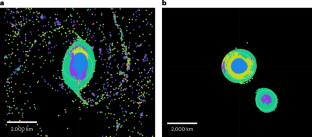2025-01-06 アリゾナ大学
<関連情報>
- https://news.arizona.edu/news/newly-discovered-kiss-and-capture-mechanism-explains-formation-pluto-and-its-largest-moon
- https://www.nature.com/articles/s41561-024-01612-0
冥王星周辺の古代カロンの捕獲 Capture of an ancient Charon around Pluto
C. Adeene Denton,Erik Asphaug,Alexandre Emsenhuber & Robert Melikyan
Nature Geoscience Published:06 January 2025
DOI:https://doi.org/10.1038/s41561-024-01612-0

Abstract
Pluto and Charon are the largest binary system in the known population of trans-Neptunian objects in the outer Solar System. Their shared external orbital axis suggests a linked evolutionary history and collisional origin. Their radii, ~1,200 km and ~600 km, respectively, and Charon’s wide circular orbit of about 16 Pluto radii require a formation mechanism that places a large mass fraction into orbit, with sufficient angular momentum to drive tidal orbital expansion. Here we numerically model the collisional capture of Charon by Pluto using simulations that include material strength. In our simulations, friction distributes impact momentum, leading Charon and Pluto to become temporarily connected, instead of merging, for impacts aligned with the target’s rotation. In this ‘kiss-and-capture’ regime, coalescence of the bodies is prevented by strength. For a prograde target rotation consistent with the system angular momentum, Charon is then tidally decoupled and raised into a near-circular orbit from which it migrates outwards to distances consistent with its present orbit. Charon is captured relatively intact in this scenario, retaining its core and most of its mantle, which implies that Charon could be as ancient as Pluto.



